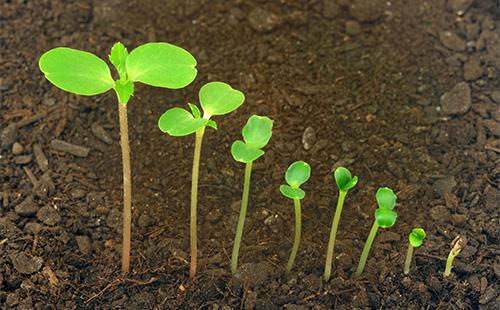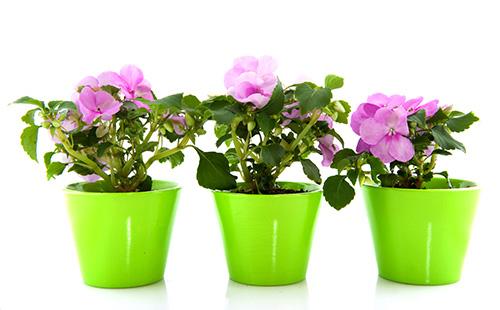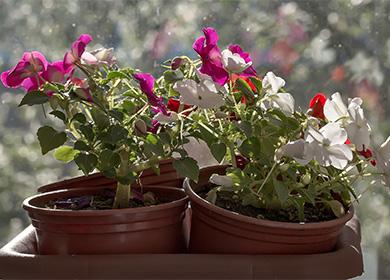The content of the article
A plant with fleshy stems, oval-lanceolate leaves blooms profusely from July to the first frosts. Due to such a long period, the English call him “Lizi's troublesome”, the Germans call him “zealous Liza”. For the expressive color and variety of shades of flowers, the Austrians call balsamin “a beautiful wreath”, comparing it with an attractive girl.
In the CIS countries, balsam has acquired many affectionate and interesting middle names. “Roly wet” is the name that came from the fact that drops of sugar liquid protrude along the edges of the leaves. The plant was called the "Twinkle" because of the bright buds.
Indoor varieties
Cultivation of the "spark" begins with the selection of varieties. The table lists the main types that can be used indoors.
Table - Varieties of balsam
| Grade | Features |
|---|---|
| Tempo F1 Hybrid | - The height of the plant can reach 25 cm; - apricot or pink buds |
| Stardust F1 Mixed | - Silver plated petals; - on the edges of a wide border in orange, red or pink |
| Bruno FT | - Abundant flowering and lush green foliage; - large-sized petals from red to lilac |
| Firefly | - The plant has a large palette of shades of flowers: orange, pink, purple |
| Fiesta FT | - Terry flowers have a rich red color. |
| Balsam New Guinea | - Abundant flowering, which lasts all year round; - the leaves may have a bronze, bright green or colorful color |
| Paradise | - Lanceolate leaves may have a dark, bright green or colorful hue; - flowers of various bright shades |
| Java | - Bronze or green leaves; - flowers of bright "tropical" shades |
| Jangle rain | - Flowers of gentle pastel colors |
Balsam care: what to consider
To "light" grew well and pleased with a healthy appearance, he needs to create favorable conditions. Knowing how to care for balsam after flowering or during the growth period, and observing simple rules, you can achieve year-round flowering or enjoy the beauty from May to December.
Lighting and location
The plant loves light, therefore it is impossible to keep it in the shade, partial shade, since in such conditions it does not bloom. But sun exposure should not be allowed. An ideal place in summer and spring is the east window. In autumn and winter it is better to place a flowerpot on the south side.
“Roly wet” can grow not only in natural, but also in artificial lighting. In order for it to have a uniform healthy crown, it should be substituted to the light source in different directions. Otherwise, balsam may stop releasing buds, will acquire an unattractive appearance.
Temperature mode
The ideal temperature in the summer is 21 ° C. Based on the feedback of gardeners, if it is higher, then the plant needs to provide high humidity and intensive watering. In winter, 10-16 ° C are excellent conditions. Frosts, cold air - this is what should be avoided.
Starting from spring, the "light" can be taken out to the balcony or terrace at a temperature of at least 15 ° C. It should be a place protected from rain, wind, direct sunlight.
Humidity
“Roly wet” does not like a dry microclimate, especially in the cold seasons when heating appliances are turned on. Humidity is maintained through periodic spraying. Water should not fall on the flowers. A plant with abundant flowering is best kept on a pallet with pebbles, expanded clay. Spraying is carried out in the early morning hours or in the evening. This avoids sunburn.
Watering
The plant needs abundant watering throughout the year, except winter. With the onset of cold weather it is limited. If the water stagnates in the sump, then its quantity must be reduced. To find out if the plant has enough moisture or too much is simple: with excessive watering, green moss appears on the soil.
"Touch" in the summer is watered at least three times a week. Winter care for balsam in a pot - watering only once or twice a week. Spraying the leaves is carried out in the early morning or evening. This avoids sunburn.
Use soft filtered water at room temperature. If you take the liquid from the tap, then over time a white coating forms on the ground. This is a sign of soil alkalization. Will have to replace its top layer.
Top dressing
From April to November, the plant must be fertilized every ten days with mineral complexes. After transplantation, top dressing is carried out after two to three weeks. The resting period of the plant is not very pronounced, therefore, additional nutrition is needed in the winter. After the buds have appeared, a small amount of fertilizer is added to the soil. It is introduced after irrigation into wet soil.
Pruning and pinching
In order for the "touchy" to have a well-groomed and healthy appearance, annual pruning is necessary. In early spring, elongated long branches are cut. The procedure is not carried out immediately, but gradually, so as not to injure the plant.
The procedure is needed so that the bush grows actively, flowering was magnificent. It is better to pinch balsam after a dive, since during this period it is actively growing. Simple manipulation is carried out at the top of the plant. Together with it, you can remove sluggish and dry leaves. Dwarf varieties do not need to be pinched.

Soil and transplant
"Roly wet" grows in a light, loose and fairly nutritious soil with a slightly acidic environment. In too loose soil, the plant will be unstable. Excessive amounts of minerals, ammonium nitrate, ammonium sulfate will lead to strong leaf growth and a small number of flowers.
You can make a composition of turf land, humus, compost and perlite. All components are taken in equal parts. Another excellent option is another composition of sand, peat (in one part) and sheet land (two parts). Humus can be taken from under linden, maple.
Transplantation is carried out every year in the spring. It is better to do this in March or April.Having decided to transplant the “light”, the gardener must adhere to certain rules. It is very important to choose a pot of the right size. If it is too large, then the plant will spend strength on the formation of roots and they will not be enough for flowering. The most comfortable conditions for "touchy" is when the roots completely fill the pot. It should be of medium volume with a small amount of soil.
Breeding methods
After three to five years, balsam is losing its decorative properties, so there is a need to grow a new plant. Cuttings allows you to save all varietal characteristics in contrast to planting seeds.
Cuttings
Features. Before propagating balsam by cuttings, materials and tools should be prepared. You need a knife with a sharp blade, a container for water, perlite, glasses, soil, a pot. For successful rooting, you can leave the cuttings in a greenhouse or cover with polyethylene. It is better to keep them under ambient light and withstand temperatures of 22 ° C.
Progress
- Below the knot, cut a stalk 10-12 cm long.
- The process is left in warm water (30 ° C).
- We remove leaves, colored buds and make up the top two leaves.
- We fill the disposable glasses with perlite and immerse the stalk 3 cm into it, pour it with warm water.
- We wait two to three weeks until rooting occurs.
- We transplant into a pot.

Seeds
Features. Growing balsam from seeds at home is only possible for simple and non-terry varieties. Sown seeds in February or March. But if you want the plant to bloom in May, then the procedure is performed in January. Seeds germinate in bright ambient light and a temperature of 22 ° C. After transplantation, the temperature drops to 18-20 ° C. Maternal characteristics are practically not preserved.
Progress
- Before planting, soak the seeds in warm water for three hours or in a solution of potassium permanganate for ten minutes.
- Gently squeeze the seeds into perlite, water.
- Create a greenhouse effect with cellophane.
- We are waiting for two to three weeks.
- Seedlings can be planted only when two leaves develop.
Possible difficulties when growing
The green pet is exposed to negative factors - diseases and pests. If you have the necessary information and correctly respond to the problem, then you can save the "touch."
Pests
The emergence and reproduction of pests is the result of unfair care. The table shows the worst enemies "touchy" and the symptoms of defeat them.
Table - Pests attacking balsam
| Pest | Symptom |
|---|---|
| Spider mite | - Small yellow spots form on the bush; - over time, spots increase and turn into colorless, dried patches; - small mites are visible on the inside of the leaves in a web |
| Multi-claw ticks | - Harden, deform, twist leaves; - small white mites appear and multiply under conditions of elevated temperatures, in a humid environment |
| Thrips | - Spots appear on the flowers, they turn brown at the edges; - during growth, deformation is observed; - insects accumulate in the stamen area |
| Aphid | - Leaves and flowers turn yellow and curly; - flowering stops |
| Whitefly | - In case of severe damage, the balsam leaves turn yellow and fall off |

Disease
Why has balsam stopped flowering? What happens to foliage? All of these conditions are understandable. The leaves turn yellow and dry - it means not enough moisture. Buds fall off - the soil is waterlogged or overdried. The stems are stretched, the plant blooms weakly - not enough light. Problems are solved by normalizing and adjusting the frequency of watering, lighting. But there are diseases caused by viruses that require surgery.Examples of symptoms are in the table.
Table - How and how the “light” is sick
| Disease | Symptom |
|---|---|
| Downy mildew | - On the outside, white spots form on the leaves between the veins; - from the inside - off-white coating |
| Brown rot | - Cuttings and shoots are affected; - stem, leaves turn brown |
| Leaf bronze | - The virus slows down growth, leads to leaf deformation |
Despite the fact that the composition of the plant is still not fully understood, there are known cases of its use in folk medicine. Ural, Caucasian, Siberian healers know how to care for balsam, and prepare infusions and decoctions from it. Means are used to treat kidney stone disease, ulcers, hemorrhoids, rheumatism.

